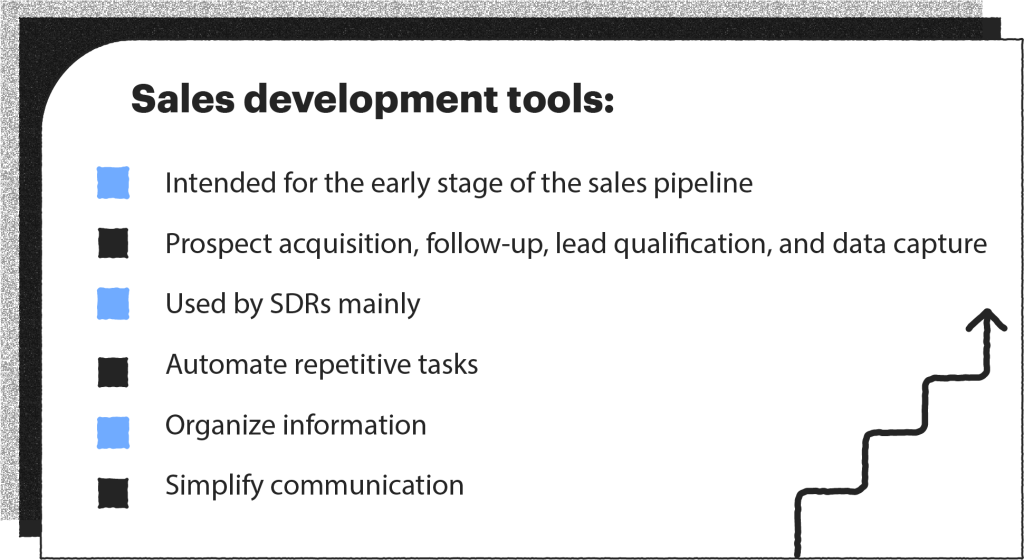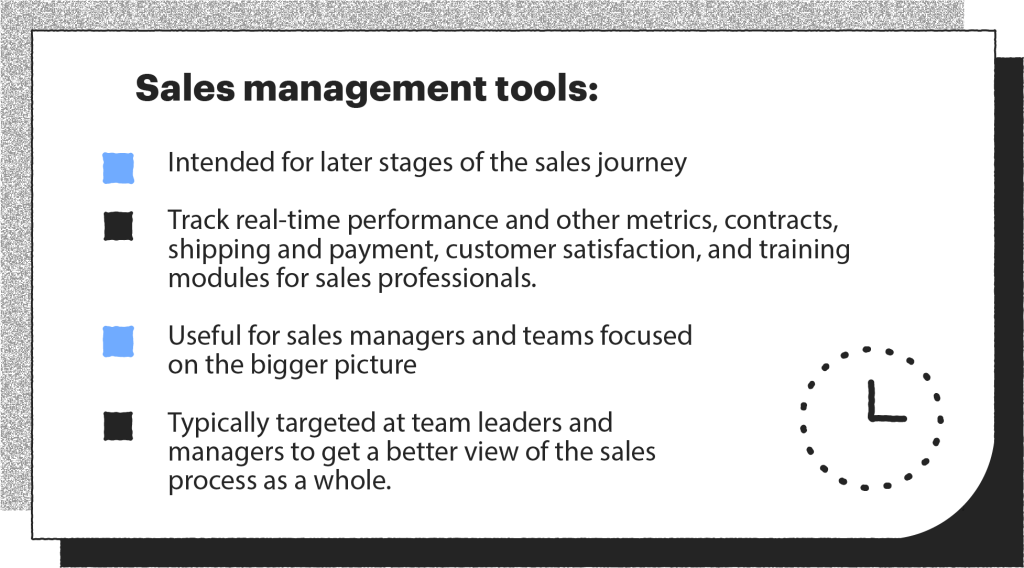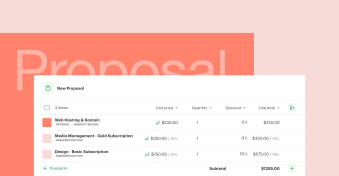Sales enablement tools are so hot right now.
It’s easy to get caught up in a rush to have the coolest new sales tools.
But even though some of them are quite useful, there are only a few that you and your team really need to be successful.
Here’s a closer look at sales development tools that can help SDRs truly nurture qualified leads and move deals further down your sales pipeline.
Sales development vs. sales management tools
Although you likely know the difference between these two terms, let’s define it openly so as to keep everything crystal clear from the onset.
Sales development tools
Sales development tools (the focus of this article) are intended for the early stage of the sales pipeline.
They help with prospect acquisition and follow-up as well as lead qualification and data capture.
The software used by SDRs may also share some attributes with other sales tools, as they automate repetitive tasks, organize information, and simplify communication.

Sales management tools
Sales management tools are typically for later stages of the sales journey.
These tools are designed to track real-time performance and other metrics, contracts, shipping and payment, customer satisfaction, and training modules for sales professionals.
This kind of software is useful for sales managers and teams focused on the bigger picture; typically, they’re targeted at team leaders and managers who are trying to track SDR progress or get a better view of the sales process as a whole.

Why you and your SDRs must love sales development toolkits
You are surely committed to growing your business through sales development.
Therefore, sales enablement tools are a no-brainer for you.
Even if you hire top-performing sales development representatives, they’ll still need a flexible toolkit in order to perform effectively in their roles.
With the right tools and clear guidelines on how to fit them into your operation, salespeople can move quickly to chase leads, secure deals, and earn revenue.
Without an organized system, sales teams can quickly fall apart.
Top-performing teams have a toolkit that fits effectively into the sales process.
Reps understand what you want them to do, and they have the tools necessary to make it happen.
A strong sales toolkit also comes with some major benefits for you and your team:
Improved efficiency
Sales professionals are always busy, so most sales tools are focused on saving time.
Some help reps create automated workflows and follow-ups.
Others do so by automatic scheduling or fast document creation with ready-made customizable templates.
For example, the existing PandaDoc pool of free document templates contains more than 750 templates for various purposes, including 167 templates for proposals alone.
Once you’ve chosen the template, created a document, and saved it, you can then access it whenever required and reuse it in the existing form or as a template for the next proposal.
This is the way to not only shorten the time of proposal creation (the record time for using PandaDoc is 3 minutes), but also to overcome most of the human errors, thanks to validation and reuse instead of creating one each time from scratch.
Enhanced prospecting and lead qualification
Prospecting is a crucial part of sales development.
Based on your approach, prospects you or your SDRs gather can be more or less fitting to your offer.
In a recent survey conducted by Sales Insights Lab, more than 70% of respondents claim that the lists they analyze usually contain 50% or even fewer relevant prospects.
Building a higher quality pipeline helps boost the share of relevant prospects, increasing their chances of being customers further down the line.
With intelligent tools and a CRM, you can learn much more about your prospects to qualify them more accurately.
This makes it possible to set priorities in order to address the most promising prospects.
More personalized and streamlined communication
Using customizable templates instead of creating proposals from scratch gives your SDRs some extra time to get to know the prospect better.
Salesforce’s Sales Transformation Survey shows that about ¾ of SDRs surveyed claim that their job became more consultative and less transactional after the pandemic.
Learning and then addressing the needs and pain points of prospects is an excellent way to build rapport and efficient interpersonal communication.
Higher conversion rates
All the benefits mentioned above result in significantly higher conversion rates. The more relevant your prospects are, the faster you can address their feedback. And the more glossy your documents look — the higher percentage of conversions you will see at each stage of your sales pipeline.
“We’ve only been using PandaDoc for a couple of months but in that time we have seen a 50% increase in sales conversions.” – Richard Gosler, Creative Director, Pixelhaus
Best SDR tools for fast and efficient sales development
If you’re trying to stay competitive in your field, having a proper tech stack is a must.
That’s true, even at PandaDoc. Our team has tools in place with the aim of maintaining maximum productivity and effectiveness.
However, it’s not a one-size-fits-all approach. Instead, we’ve identified a handful of tools that address the specific challenges that our SDRs face.
But, while the software tools might be different, the needs are almost always the same.
With that in mind, we’ve broken our SDR tools and recommendations into categories based on what you’re most likely to need to create a successful sales development toolkit.
1. CRMs
We bet you’re already using a CRM within your sales process, right?
CRM software is important for any business larger than those that are micro-sized.
The average ROI according to one prominent 2014 study clearly illustrates its importance, with an expected $8.71 return for every $1 spent on CRM — and an annual growth rate at the time of 1.5x (meaning an ROI percentage that is all but certain to have grown by now).
Think of a CRM as the collective digital memory for your sales organization.
You can’t expect each individual rep to remember how they’ve interacted with every prospect, but it’s important to store that information for future reference.
Even for small sales teams, manual data management can dramatically hamper productivity.
This is where CRMs are valuable because they allow your team to break away from spreadsheets and unorganized notes as they qualify leads.
A properly set up CRM can provide deep insights into the effectiveness of your sales team and the health of your company. Simply put, you cannot create a data-driven sales team without implementing and maintaining a CRM.
Here are a few CRMs that you should consider when thinking about building out or reforming your SDR team.
PandaDoc offers smooth integrations with all of the CRMs we recommend above for sales development purposes, and integrates flawlessly with many other tools as well.
Once the CRM is connected with your PandaDoc account, you can use your client data from the CRM to automatically fill in the fields for your proposals, quotes, and other documents you generate from templates.
As a result, the documents are created in minutes and without errors.
If you’re looking for a way to connect the data in your CRM to the sales documents and collateral your team needs to create, these integrations are powerful ways to put your data to work for you.
2. Lead sourcing
Gone are the days when “dialing for dollars” was considered an efficient way to generate new business.
Modern sales organizations need more than a phone book and a few cold calls to gain traction.
You need high-quality prospect data to set yourself apart from the competition.
Unfortunately, the overwhelming majority are pedaling low-quality data that is scraped from websites. These lists come from traditional “static” databases.
Most of the data is months (even years) old, which is an eternity in B2B sales.
For market intelligence and sales data to be useful, it needs to be up-to-date, industry-specific, and enriched with accurate details that make it actionable.
While it’s possible to find some of this data manually using tools like LinkedIn Sales Navigator, teams looking to scale need to compile leads more quickly.
By the way, LinkedIn Business Directory is currently the biggest B2B prospecting database ever, containing info on over 58,000,000 companies globally.
Here are a few other tools you might also consider:
ZoomInfo is our selection at PandaDoc. It’s an excellent source of high-quality prospect data.
The accuracy is high, and the cost is quite reasonable when you factor in labor and opportunity costs.
Remember: In order to close deals, SDRs need to spend time talking to people, not searching for a phone number.
So, if you need unique data that isn’t available through normal channels, look into LeadGenius.
The company employs a virtual workforce of over 500 trained researchers whose only job is to scour the web for prospects’ data and enrich it with whatever other data points are important to you.
They deliver customized prospect data at scale.
3. Meetings and scheduling
At PandaDoc, we’re pretty busy, and that makes scheduling meetings with other busy people difficult.
Nowhere is this more of a problem than in B2B sales.
Trading emails with a C-level executive to set up a meeting can take days. It’s inefficient and, more importantly, it elongates the sales cycle in unnecessary ways.
After initial introductions, it’s best to cut to the chase and find the best time to talk.
The best tools for the job are those that display your availability and give your prospect the ability to pick a time best suited to their own availability.
For that, you’ll need a calendar automation tool like those we’ve listed below:
Both of these scheduling apps are similar and allow inbound leads to set up a chat by providing a phone number or an email address.
You can even integrate your scheduling tool with your CRM or with a video conferencing tool like Zoom for automated data capture and meeting link generation.
4. Outreach automation
While setting up meetings is fundamental to sales development, it’s only a small part of the work.
Making contact with prospects often happens multiple times over several different platforms.
Instead of manually reaching out and then planning and tracking follow-up calls, outreach automation can handle the repetitive and time-consuming part of the task.
Here are the best prospecting tools to incorporate:
Auto-dialers
These tools improve call uptime by helping your team get on the phone faster and reduce delays between calls.
You can even connect them to your CRM so that phone calls are generated based on numbers within your database.
Email templates
PandaDoc’s customizable templates for your emails allow your team to quickly generate and send outreach emails to new leads and prospects.
These are great for everything from thank-you emails to post-call recaps, which makes them great candidates for sales prospecting.
Analytics
This toolkit can help you measure success and determine the best approaches for various aspects of your business.
You can use analytics tracking to see which reps are most productive, who has the highest close rates, and even how customers respond to the sales documents sent from your team.
Task lists
Useful for elements where someone needs to step in and administer manual controls.
Even with a slew of powerful automation tools at your disposal, some things will still need a personal touch.
The tools you need to build automation into your sales pipeline will depend on your company size and exactly what needs to be automated.
Some great tools, like Salesloft or Salesforce Customer 360, might be too big for a small business, especially if you’re just looking for solutions to handle outbound prospecting rather than full-scope customer management.
Fortunately, there are tons of smaller tools out there that can be easily added to your automation playbook.
Let’s take a look at email automation as an example.
Quickmail.io is a powerful and affordable email automation tool that has an absolutely flawless user interface. It’s one of the best-built software tools we’ve ever seen.
On the other hand, tools like Outreach.io will automatically email prospects on your behalf and generate a running list of tasks that remind you which steps in your prospecting cadence need to be completed manually.
And, naturally, both of these tools come equipped with analytics so that you get deep insights into the success of your prospecting campaigns, A/B test different approaches, and determine which members of your team are achieving the best results.
We have more good news: PandaDoc has been developing some cool new features.
The first is the possibility to send emails via your own business email, which must be first connected to the app. This feature is still in close beta.
Another interesting feature is already available as a paid addon to the Business pricing plan. You can simply outsource your email delivery tasks to PandaDoc.
Our platform will send your emails via a specially created business email looking like your corporate one.
How to pick the right sales tools
There are hundreds (thousands?) of sales tools available on the market today.
A quick search will yield dozens of top-performing task management tools, auto-dialing systems, and prospecting tools to help you with everything from cold calling to closing deals and onboarding.
But how do you know which tool is right for you?
It’s possible to overburden your sales team with too many tools or with tools that offer too many similar features.
That can lead to disaster as each SDR develops workflows and processes that don’t fit with the rest of your sales pipeline.
Before you purchase a new library of tools for your team, ask yourself the following questions:
1. Does this tool integrate with my current tech stack?
If your new tool requires access to or data from other sources, such as your CRM, communication systems, or calendar, then doing some research on whether the software can work together is necessary.
It’ll save you a lot of problems or from having to switch programs at a later date due to incompatibility.
2. Do we require training?
You and your team will be using this software every day.
While training requirements aren’t necessarily a deal-breaker, it’s essential to know how much time, commitment, and extra costs are required before you’ll see the benefits of using the tool.
Keep in mind that specialized training (often from the company that sold you the product) can quickly become expensive.
If you’re paying hundreds or thousands for enterprise-level software, don’t be surprised if a few hours of hands-on training courses cost almost as much as your annual subscription.
3. What are the limitations?
Every tool has its weak points and limitations.
While you might intend to save time, setting up and maintaining task management or automation software requires input.
Be realistic about what you give and what you get in return.
Overall, you need to be comfortable with the compromises you make. It could be a lack of integration, fewer functions, more training, or higher subscription fees.
Draw those lines and then make your choice to avoid disappointment.
4. Will it work for us?
Your company size, collaboration methods, and specific industry will all impact your sales tools decisions.
While most sales development cycles have similar processes, what your team experiences will be unique. This can and should impact the solutions that work for you.
Keep in mind that the tools you use will also help to define how your business interfaces with its customers.
You don’t have to use the exact same tools that your competitors use.
In fact, you may be able to create stronger relationships and more effective processes by investing in tools that will grant you a competitive edge.
At the same time, you may also want to ensure that your tools allow you to track key SDR metrics to monitor performance.
Before buying, make sure that the software tool you choose offers the information you need to be successful.
5. How do we measure success, and can we change course?
Metrics are an important way to determine whether a tool is serving the intended purpose.
If you identified your pain points before purchasing, then you’ll know what to look for when evaluating monthly performance.
For sales development, that’s usually better quality leads, more time spent on progressing and less on repetitive tasks, and more effective communication that speeds up the sales cycle.
After evaluation, if a tool isn’t providing the benefits you expected, you’ll need a plan.
This will depend on several factors, including how much you’ve invested in terms of time and money in this tool.
If the subscription is easy to cancel and changing will be relatively painless, then opt for a new tool. Otherwise, adjusting processes and training might be the answer.
The bottom line is to always do your due diligence before you begin.
Addressing your needs and pains with PandaDoc
When you’re building your perfect sales pipeline, it’s worth remembering that documents and paperwork are a big part of it.
Let’s now identify all the needs SDRs can face and then show how PandaDoc helps overcome them.
I need to increase my sales team’s efficiency and accuracy to drive revenue results and produce accurate forecasts
If your sales team still uses paper planning or chaotically chooses separate office apps for different stages, the plan is obvious:
- Review, fix, and optimize your existing processes. This step alone will likely increase your team’s performance significantly.
- Connect your CRM and PandaDoc.
- Start crafting proposals using PandaDoc templates and filling them with the data from your CRM.
Once implemented, your team’s performance will increase multifold.
Analyzing similar proposals sent previously and comparing current efficiencies and results will help produce more accurate forecasts.
I need to minimize the time it takes to prepare and close a deal.
To minimize the preparation time, you should act in step with the previous example.
For faster deal closing, there is a set of efficient features that PandaDoc offers:
- A collaborative environment and instant notifications help negotiate details much faster.
- A free eSign option is also a strong argument for getting deals done quickly.
- Pricing tables with options and related data make it possible to adjust prices without the need for additional meetings.
- With interactive showcasing, Advanced Quotes is the most powerful tool to make deal closing faster. Based on predefined workflow and rules, it preconfigures the document template and sets strict rules so SDRs cannot breach them.
I need to maintain a solid relationship with new and existing clients, providing them with killer demos while minimizing churn
PandaDoc has various features that help you maintain good relationships with clients, which assists in reducing churn:
- Our compelling document templates consistently turn out into the same attractive proposals, quotes, and other documents that clients like to receive.
- Setting up an efficient, collaborative, and transparent environment is also a way to deal with your clients better.
- Instant notifications help all parties be 100% aware of any possible changes.
I need to stay organized and on top of open deals
PandaDoc integrated with your CRM helps maintain actual statuses in real-time, so you will be aware of all deals currently open, as well as of any other important changes.
I need to stay compliant
Changes in laws and regulations happen quite frequently, so it’s sometimes hard to control them all and adjust and update your sales activities accordingly.
PandaDoc constantly monitors the situation and will inform you about any changes.
For example, PandaDoc is 100% compliant with HIPAA and GDPR.
You can check the efficiency of the PandaDoc platform and how it relates to your needs with no risk whatsoever.
Just start a free 14-day trial and see for yourself!
Disclaimer
PandaDoc is not a law firm, or a substitute for an attorney or law firm. This page is not intended to and does not provide legal advice. Should you have legal questions on the validity of e-signatures or digital signatures and the enforceability thereof, please consult with an attorney or law firm. Use of PandaDocs services are governed by our Terms of Use and Privacy Policy.
Originally published December 15, 2017, updated November 9, 2023


